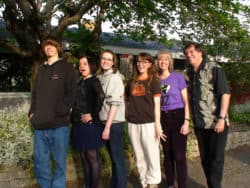
The Origin of Or So It Seems stories
This was the debut column “back in the day.” The series has spun off several variations, including “ThinkingFunny.com,” and “TheLandOfBadIdeas.com.” Now, orsoitseems.com is the home of long-form humor/mysteries.
Or So It Seems … Tall Tales and Tedious Trips
By Robb Lightfoot July 31, 2012
Editor’s note: Readers, please join me in welcoming Robb Lightfoot and his new column, “Or So it Seems,” to anewscafe.com’s family of talented writers and contributors. I think it’s going to be good! ~Doni
Welcome to “Or So It Seems….” The line comes from a trick I’d play on my family. On trips, we’d do round-robin storytelling, each person building on the previous narrator’s tale. When I decided I didn’t like the direction the story had taken, I opened with “Or so it seems….” and then took the story off to where I wanted it.Of course, the problem with this trick is that it can come back to haunt you. Pretty soon, revisionists made our stories more complicated than California’s Constitution.But at least they were more interesting.Convoluted or not, stories are wonderful but elusive beasts. Whose stories do you believe? What really happened? Can we ever know?There’s the rub.So relax, sit back, and see if you can decide what really happened.And when you figure it out, please me know.
Or So It Seems … Column No. 1: Tall Tales and Tedious Trips
I come from a family that loves good stories. When I was a kid, at our dinner table, everyone talked about their day, usually all at the same time. We’d take turns topping one another. There was lots of love, some shouting, laughter, and many a memorable tale.
Some of the stories even had the added advantage of being true.
Dinner guests who were first-time visitors were often taken aback until they learned to just wade in and speak their piece. At grade school, I would talk up a storm, retelling these stories, shouting out answers to the teachers’ questions, and filling in the punch lines to other people’s jokes. I wanted attention, and I got attention. Lots of attention. I was given my own special reserved-seating desk in the principal’s office.
As I recall, my first-grade teacher had a stack of referral slips with my name already dittoed on them, and the box “talking in class” checked off. I remember this, and it may have actually happened….So I survived school and, oddly enough, ended up back in the classroom again.
I make my living by forcing other people to talk in class—I’m a speech teacher. My subjects include how to overcome fear of talking—hint, do it a lot—and factual research methods. In fact, I’m all for facts. But I also cover literature in performance, and storytelling, too. I know that a good story sometimes wanders into the land of the tall tale.Great fiction reveals the truth by telling a compelling story.
But even non-fiction narrative can offer conflicting views of reality. It just depends. My graduate thesis was a study of “competing political narratives,” which is a fancy way of saying I examined two stories where the heroes and villains were reversed and each side wanted to win to gain a big hunk of real estate. Who or what to believe? It’s hard to know sometimes.
When my four kids were little, we’d pass the time on long trips by telling original, convoluted stories. It worked like this. My wife, Karin, or I would begin the yarn, and after a few paragraphs—a chapter—hand it off to one of the kids. The new narrator would pick up the thread and go on. The story would unravel as it moved around the van.
By the time it made it back to me, the plot was a hopeless tangle. How? Why? Who knew?Sometimes, when we were overdue for a rest stop, a back-seat troll might kill off my favorite character.
One time this happened, just as the story-telling-staff was passed back to me, and I decided a case of literary CPR was in order. I revived my character, Wilbur.A howl arose from the back seat.“You can’t do that,” the Greek chorus said.“Do what?” I replied in innocence.“Bring back Wilbur.”
“But he’s not really dead”. “They found his body floating in the lake,” my daughter Amanda said.
“Or so it seemed….” I said. “Later tests proved it wasn’t him”. My daughter fumed.
“So who was it?”
“Don’t know.”
Somehow, this answer didn’t satisfy Amanda, She’d taken a personal dislike to Wilbur. All my heroes were named Wilbur, and she’d apparently had enough of them. So when the story circled back around to her, she sought her own revenge.
Wilbur was about to get married… a happy ending was in view. And then Amanda struck.
“But the police arrested Wilbur and threw him in jail. He was convicted of murder and executed.”
“Hey,” I protested, “Why would they do that?”
“Because it was someone impersonating Wilbur,” she said.
“But the tests proved it wasn’t.”
“Or so it seemed,” she said. I saw her smile in my rear-view-mirror.
“But the Wilbur-impersonator snuck into the lab and changed the test tubes.”
“How did they know?”
“He left a fingerprint on the test tube, and a brilliant investigator named Amanda figured it out,” she said.
“The end.”
And that was when the “Or So It Seems” method of storytelling entered our family history. At least that’s how I remember it. It could have happened.
You’ll have to ask Amanda.

















































